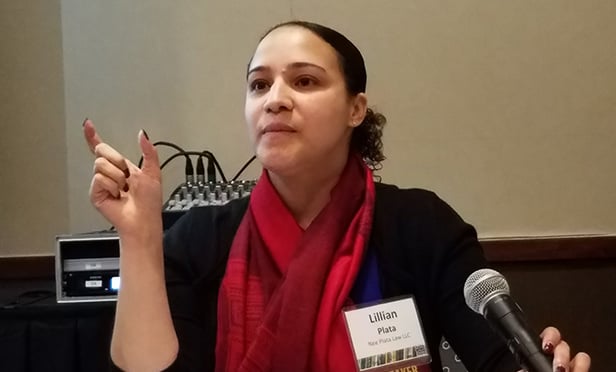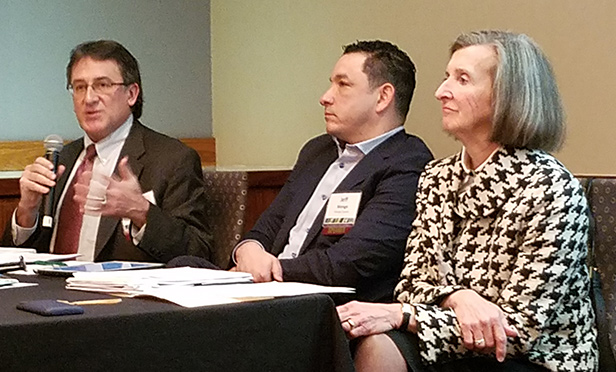 Lillian A. Plata, founding member of Nee Plata Law, discusses opportunity zone regulations at the New Jersey Future Redevelopment Forum in New Brunswick, NJ (Steve Lubetkin Photo/State Broadcast News)
Lillian A. Plata, founding member of Nee Plata Law, discusses opportunity zone regulations at the New Jersey Future Redevelopment Forum in New Brunswick, NJ (Steve Lubetkin Photo/State Broadcast News)
NEW BRUNSWICK, NJ—Developers seeking to take advantage of the newly launched federal rules regarding Opportunity Zones in economically disadvantaged census tracts need to be aware of special rules governing these investments that might not be immediately obvious in the high-level descriptions of the Opportunity Zone program being widely circulated, say panelists at last week's New Jersey Future Redevelopment Forum breakout session on the topic.
Opportunity Zones provide a way for investors to defer taxes on capital gains from other kinds of investments if those gains are invested in real estate projects in those zones on a strict schedule, but some provisions of the law could cause complications for different types of investors, the panelists say.
For example, some partnerships that declare their gains in January would need to invest those gains by the end of June, or they would face a six-month block to investing them in the second half of the year, says Lillian A. Plata, founding member of Nee Plata Law.
“If you are a partnership, you do have two blocks of six months that you can choose to invest your gains,” she says. “If the partnership itself does not elect to invest the gain in a new project, the partners have 180 days from that date. But what they can't do, they cannot invest their gain between June 30th of 2019 to December 31, 2019. So there is a six month blackout.”
Developers completing a “substantial rehab” of a property have 30 months from the date they acquired the property to spend money on that rehab from investment gains placed into an opportunity fund, Plata says.
“Substantial improvement” has a specific definition in the opportunity zone rules, says panelist Brent T. Carney, a partner with Maraziti Falcon.
 Brent T. Carney, a partner with Maraziti Falcon, makes a point while opportunity zone panelists Jeff Monge, managing partner of Monge Capital and Anne S. Babineau, a partner with Wilentz, Goldman & Spitzer, look on at the New Jersey Future Redevelopment Forum in New Brunswick, NJ (Steve Lubetkin Photo/State Broadcast News)
Brent T. Carney, a partner with Maraziti Falcon, makes a point while opportunity zone panelists Jeff Monge, managing partner of Monge Capital and Anne S. Babineau, a partner with Wilentz, Goldman & Spitzer, look on at the New Jersey Future Redevelopment Forum in New Brunswick, NJ (Steve Lubetkin Photo/State Broadcast News)“Substantial improvement is defined by the IRS to mean that you're basically going to spend one more dollar than doubling the basis of the building, within a very tight time frame of 30 months,” Carney says. “My concern for those that are familiar with redevelopment areas or even rehabilitation areas in the state of New Jersey is, 30 months is usually not a lot of time.”
Rules that normally view 50% ownership as the threshold for determining if companies are related parties are further limited under the Opportunity Zone program, Plata says. Under the OZ rules, 20% cross ownership is the maximum level, and convincing developers to give up 80% of the equity in a project to another investor may be difficult.
“I think a lot of tax credit developers are probably more amenable and comfortable with the OZ programs and the restrictions, because normally, a developer only owns about 0.1% percent in a LIHTC deal, and they're very used to giving LIHTC investors 99% of their of their company,” Plata says. “New Market tax credit investors are not that comfortable with it. They're not used to having equity investors coming in and taking the majority of the percentage interest, so you should really keep that in mind.”
Developers should focus less on the benefit from the opportunity zone incentives and more on the overall return from investing in the property, says Jeff Monge, managing partner of Monge Capital. He says his analysis of the benefits of the OZ program work out to about 200 basis points over ten years, which an unprepared investor could easily fritter away.
“If you've never invested in the Newarks of the world, and you don't believe in that, or understand the complexity of it, you're probably going to lose your 200 basis points because you're not going to know what you're doing in the first place,” he says. “It's really about the appreciation after those 10 years. That's when it all makes sense, because you're not paying the capital gains in that appreciation. If you don't have the appreciation, who's going to invest for 10 years and not get the pop that you were hoping for, but you're taking on the risk because you don't know how to invest in low-income communities.”
Also on the OZ panel were Anne S. Babineau, a partner with Wilentz, Goldman & Spitzer; and Eduardo J. Rodriguez, Director, Department of Planning and Community Development, City of Elizabeth.
CORRECTION, 3/12/2019, 8:48 a.m.: Because of a transcription error, an earlier version of this article mischaracterized a quote from Lillian Plata. She was referring to investors familiar with the “Low Income Housing Tax Credit,” or LIHTC.
© Touchpoint Markets, All Rights Reserved. Request academic re-use from www.copyright.com. All other uses, submit a request to [email protected]. For more inforrmation visit Asset & Logo Licensing.







